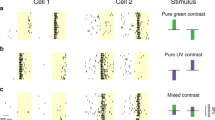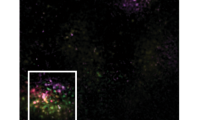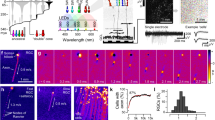Abstract
THE colour-opponent and broad-band channels of the primate visual system originate in the retina and remain segregated through several neural stations in the visual system1–7. Until now inferences about their function in vision have been based primarily on studies examining single-cell receptive field properties which have shown that the colour-opponent retinal ganglion cells have small receptive fields, produce sustained responses and receive spatially segregated inputs from different cone types; the broad-band cells have large receptive fields, respond transiently and receive cone inputs that are not spatially separated8–11. We have now examined the visual capacities of rhesus monkeys before and after interrupting either of these channels with small lesions at the lateral geniculate nucleus. Here we report that the colour-opponent channel is essential for the processing of colour, texture, fine pattern and fine stereopsis, whereas the broad-band channel is crucial for the perception of fast flicker and motion. Little or no deficits were found in brightness and coarse-shape discrimination, low spatial frequency stereopsis and contrast sensitivity after the disruption of either of the channels.
This is a preview of subscription content, access via your institution
Access options
Subscribe to this journal
Receive 51 print issues and online access
$199.00 per year
only $3.90 per issue
Buy this article
- Purchase on Springer Link
- Instant access to full article PDF
Prices may be subject to local taxes which are calculated during checkout
Similar content being viewed by others
References
Rodieck, R. W. A. Rev. Neurosci. 2, 193–225 (1979).
Livingstone, M. & Hubel, D. Science 240, 740–749 (1988).
Martin, K. A. C. Trends Neurosci. 11, 380–387 (1988).
Lennie, P. Vision Res. 20. 561–564 (1980).
DeYoe, E. A. & Van Essen, D. C. Trends Neurosci. 11, 219–226 (1988).
Ungerleider, L. G. & Mishkin, M. in Analysis of Visual Behavior (eds Ingle, D. J., Goodale, M. A. & Mansfield, R. J. W.) (Massachusetts Institute of Technology, Cambridge, Massachusetts, 1982).
Zeki, S. M. & Shipp, S. Nature 335, 311–317 (1988).
De Monasterio, F. M. & Gouras, P. J. Physiol, Lond. 251, 167–195 (1975).
Gouras, P. J. Physiol., Lond. 204, 407–419 (1969).
Schiller, P. H., Malpeli, J. G. & Schein, S. J. J. Neurophysiol. 42, 1124–1133 (1977).
Derrington, A. M., Krauskopf, J. & Lennie, P. J. Physiol., Lond. 357, 241–265 (1984).
Dreher, B., Fukuda, Y. & Rodieck, R. W. J. Physiol., Lond. 258, 433–452 (1976).
Leventhal, A. G., Rodieck, R. W. & Dreher, B. Science 213, 1139–1142 (1981).
Schiller, P. H. & Malpeli, J. G. J. Neurophysiol. 40, 428–445 (1977).
Wiesel, T. N. & Hubel, D. H. J. Neurophysiol. 29, 1115–1156 (1966).
Hubel, D. H. & Wiesel, T. N. J. comp. Neurol. 146, 421–450 (1972).
Merigan, W. H. & Eskin, T. A. Vision Res. 26, 1751–1761 (1986).
Shapley, R., Kaplan, E. & Soodak, R. Nature 292, 543–545 (1981).
Schiller, P. H. & Colby, C. L. Vision Res. 23, 1631–1641 (1983).
Derrington, A. M. & Lennie, P. J. Physiol., Lond. 357, 219–240 (1984).
Merigan, W. H., Katz, L. M. & Maunsell, J. H. R. Invest. Ophthalmol. Vis. Sci. Suppl. 30, 53 (1989).
Lee, B. B., Martin, P. R. & Valberg, A. J. Physiol, Lond 404, 323–347 (1988).
Heywood, C. A. & Cowey, A. J. Neurosci. 7, 2601–2617 (1987).
Schiller, P. H., Charles, E. R. & Logothetis, N. K. Invest. Ophthalmol. Vis. Sci. Suppl. 29, 328 (1988).
Author information
Authors and Affiliations
Rights and permissions
About this article
Cite this article
Schiller, P., Logothetis, N. & Charles, E. Functions of the colour-opponent and broad-band channels of the visual system. Nature 343, 68–70 (1990). https://doi.org/10.1038/343068a0
Received:
Accepted:
Issue Date:
DOI: https://doi.org/10.1038/343068a0
This article is cited by
-
Predictive encoding of motion begins in the primate retina
Nature Neuroscience (2021)
-
Sensations from a single M-cone depend on the activity of surrounding S-cones
Scientific Reports (2018)
-
Managing complexity: from visual perception to sustainable transitions—contributions of Brunswik’s Theory of Probabilistic Functionalism
Environment Systems and Decisions (2017)
-
Blindsight depends on the lateral geniculate nucleus
Nature (2010)
Comments
By submitting a comment you agree to abide by our Terms and Community Guidelines. If you find something abusive or that does not comply with our terms or guidelines please flag it as inappropriate.



